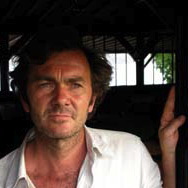Yves Cape lenses Persécution and White Material
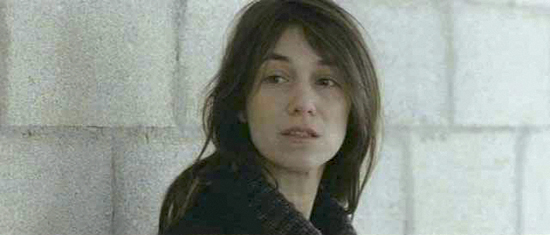
Interview with Yves Cape, AFC, SBC
Shooting Patrice Chéreau’s Persécution and Claire Denis’ White Material
Excerpted from La Lettre de L’AFC 191, October 2009, courtesy of AFC
Eric Guichard : The latest Venice Mostra scheduled two films in competition for which you had been the DOP: Patrice Chéreau’s Persécution and Claire Denis’ White Material. Let us begin with Patrice Chéreau’s film.
I remember you told me you had been considering to do tests with the RED camera ,but in the end you shot in 35 mm. When exactly did you decide to perform these tests and why did you ultimately opt for 35 mm?
Yves Cape : During one of our first encounters, Patrice Chéreau brought up the idea of shooting the film in HD, but did not specify. He only wanted to know whether I would stay aboard if he did. I answered ‘yes’, without hesitation. Once he was sure I was on his side, Patrice specified what he was thinking about: he had recorded one of his theatre productions using a RED and he had been surprised by the quality. So he wanted to find out what the advantages would be on an aesthetic and on an economic level. Shooting on film was, he said, out of the question. On the set, Patrice’s work with the actors is a process during which things constantly evolve. They know where a scene will begin, but they do not know where it will end. That means it would take a lot of shooting before getting where he wanted. And as we had to work on a rather tight budget – 4 million Euros – with a top cast: Charlotte Gainsbourg, Romain Duris and Jean-Hughes Anglade, among others – we could not afford 2,000 meters of 4-perf film a day.
So I went to see Raphael Bauche, whom I knew and with whom Patrice had made the RED recording of his performance. Raphael is highly familiar with the RED and the corresponding post-production process. I also went to see Frédéric Savoir of Amazing Digital Studios with whom Move Movie, the film’s production company, usually works. Frédéric knows the various HD cameras very well and the specific post-production processes involved. Together, we decided to test the RED, the D21 in both 4:4:4 spherical and RAW anamorphic mode, and Super 16. All these cameras have the 2.40 screen ratio we had in mind for the film. On that occasion I insisted we would perform 2-perf tests as well, but the producers thought the budget would not allow it.
We performed tests for three days. Day one we brought all the material together at TSF, looking at the different handheld options, the recording systems, the accessories, the monitors, the wireless video assist and the place of each of these features in the different positions, etc. On day two we did technical tryouts in the studio and on location (INT/EXT): key light, contrast, etc. On day three we went to the principal set (a loft at Montreuil) with two actors, Patrice, a dolly and some lighting. This third day proved extremely useful and interesting. Patrice took a look at the size of our sets and took the opportunity to consider possible options for blocking of the scenes. We had decided not to take technical problems for each format into account in order to be able to make accurate comparisons. We shot the same frames in each format. We also shot at daytime and at night and learnt a great many things from these tryouts. The D21 equiped for handheld use with motors for focus and iris control, venon mags etc.: 24 kilos! The Red: 19 kilo… ergonomics I do not like at all… On the other hand, I did not intend to use other than an optical viewer and certainly not any of this quality. The RAW D21 requires a cart with hard drives, etc. It is a bit more reasonable in 4:4:4: only a HDCAM SR deck! In brief, all this would take us far from what Patrice wanted: a mobile camera – something only Super 16 could finally offer. Moreover, the D21 had just arrived at TSF at that moment and I did not feel like turning the set into an experimentation platform at all. We graded all the test shots with Frédéric Savoir at Amazing Digital Studios. As everyone knows, the final result highly depends on the applied workflow. Nobody had performed any D21 colour grading in Paris at the time and the colour grading of RED transferred on film was only just beginning (there had been some tests, but there was no finished film). The results we got are, therefore, resulted from the workflow we applied at Amazing at the time. Amazing’s RED and D21 workflows, by the way, have greatly evolved since then. But for from our tests we quickly realized that the D21 allowed for easier colour grading than the RED, especially to obtain natural flesh colour, something which was no problem at all for s16. Technically, the D21’s exposure latitude is close to 35 mm film (9 diaphs more or less), the RED’s is less. In the white and black areas, the D21 creates a texture close to what we know from 35 mm, which was certainly not the case with the RED. We recorded a selection of these tests on 35 mm at Eclair and had a look at everything. The images of the D21 were very exact: correct flesh tones, a broad exposure margin and even when the overexposure point is reached, the texture remains interesting. Same thing in underexposure, beautiful texture and generally excellent colour rendering. The RED images were horrifying! Narrow exposure margin, narrow underexposure margin, incorrect flesh tones, frightening colour rendering, but still very fine texture nevertheless! As far as texture is concerned, Super 16 remains far behind these two very smooth cameras, showing grain defects especially in 400 ISO. Realising that it would be impossible to shoot handheld with the D21 for 8 weeks, we did not make much progress! So, after long discussions, Patrice finally took the responsibility by saying that he would make the necessary economies to shoot on 35 mm, 2-perf with a 2.40 screen ratio.
Do you utilize virtually the entire image plane?
YC : The image plane of a 2-perf 2.35 image is 30 % smaller compared to the size of a 3- or 4-perf 2.35 image. That is a lot. For this film, however, this was no obstacle. I wanted a sallow image, that would never be ‘clean’, to be more precise – so extra grain suited me fine. I shot everything in Kodak 500T 5219 just to be prepared for everything.
You abandoned using Super16 ?
YC : He thinks it is too grainy, too blurry and it also has this disadvantage one always has with 16 mm (if you respect the physical distances between camera and actors Patrice prefers) to use selective focus. S16, as a result of its grain texture and the size of the negative, has a tendency to have more depth of field. In order to tone that down a bit, you have to manipulate the distance to the actors, and use longer focal lengths. But Patrice obviously does not like that. He wants to be at an exact distance from his characters, at human distance. That is one of the few advantages of the RED, because the RED has, as a result of the size of its image sensor, very little depth of field.
And it is not too expensive either!
YC : The RED has an advantage within a certain type of economy: the camera is not too expensive, it is possible to mount your own editing room and to perform the colour grading yourself on Final Cut and Color. In the US, a lot of independent films are made like this nowadays. I think that today the workflow has been established. Still, its image sensor and the way the signal is compressed are what they are.
It’s a different production method.
YC: Film stock has become expensive compared to the alternatives, Kodak will have to make adjustments, otherwise… With its new camera for 2010, Arri definitely takes the step towards HD.
Would 4-perf force you to apply photochemical colour grading, or would digital colouring be possible?
YC : Our budget left us no choice: in 4-perf, we would have had a traditional colour grading, but in 2-perfs, we hàd to apply a DI. For the time being, it is impossible to perform an optical blow up. I hope it will soon be possible. DI is expensive. Traditional 2-perf grading, that would be interesting.
Was it interesting for you to shoot on Super 35 and to apply digital colouring in the project as Chéreau wanted to define it?
YC : This film did not require digital colouring. But still, it is a fantastic tool. We spent three weeks with Isabelle Julien. Patrice (and he is not the only one) sees disturbing differences compared to traditional colour grading, even though he feels unable to define precisely what it is that disturbs him. In the flesh colors, in low light, in the colour you can notice a certain difference. But on the other hand, it allows us to work on contrast, on the colours, on certain zones. I noticed that for underexposed low contrast images, it is better to work directly from the negative. We should, therefore, use more light! And it is the flesh colours that are particularly disturbing. Be it in HD or in digital colouring, it is often the flesh colours, oddly enough. This is the second film that I am working on entirely digitally (Bruno Dumont’s Hadewijch was the first), and every time, I come across new problems.
We’ll come back to that later. How are the first meetings with people such as Claire Denis and Patrice Chéreau, who are used to working with the same people in close collaboration – the first with Eric Gautier and the other with Agnès Godard – I mean, from the moment the deal has been made that you’re in?
YC : Once they have made a deal with a new DOP, both Patrice and Claire eagerly look forward. They do not look back, but ahead instead and assess the new DOP’s strengths and weaknesses. And they use them. After we returned from Africa, I watched the rushes with Claire, and I felt devastated: on screen they looked dry, harsh and shrill, quite the opposite of Agnes, whose shots look magnificently fluid on screen. There were no pauses between the reels and I sank deeper and deeper into my seat! But after we’d done them all, Claire stood up and said: «My God, Yves, I love your disjointed way of handling the camera!» Better quickly forget about making comparisons: my work will, obviously and inevitably, be different. Comparing is useless. It is only a matter of making choices between different approaches, different styles. On the set, both filmmakers keep close to the DOP and it’s really exciting: there intense interaction between the actors, the director and the camera. I don’t think I’ve ever experienced that before. The only comparison I could, perhaps, make, is with Bruno Dumont. He is absolutely the opposite in all respects: he directs the camera and the set-up, and on the other hand he directs his actors and then confronts them with each other. With him, things are done all at the same time, which was unusual for me. No anxiety in the beginning. The two directors we are talking about here treat their DOP extremely generously. There is never a word of reproach. We carry on, go ahead. Reproaches are useless. It is useless to say: “that was not done properly”. You must carry on. They consider the entire operation as a unity: you must create an overall osmosis. Claire made me do things I would never have dared: light the night with just a single Chinese lamp, for instance… She persuaded me to do it, and the result was magnificent. They are the kind of people that bring out the best in us, that make us throw habits overboard. The same thing happened with Patrice. I would never have ventured to push the shots that far. Patrice’s film is a true mix of shoulder and dolly shots. The first day, when we started to prepare the dolly set-up, I had trouble with my key grip – we began almost together. It was really impressive. But, in the end, Patrice’s film looks like a film by Patrice and Claire made a film by Claire… That puts us back where we belong!
Patrick had got used to making films on a budget that, without being luxurious, left him some elbow room. Did the fact that he now had to work on a budget in which each euro mattered, challenge him to question himself or was it the other way around?
YC : Patrice’s latest films were made on a modest budget. Working with another producer definitely created a positive energy in him. He wanted ten-hour days on the set, and made the film in 42 days. I thought he treated everybody with respect and that he was very kind and charming on the set. You have to be brave and strong to resist him, but it’s worth the trouble, because it is then that things really become interesting. But you have to pay attention, because his mind moves so quickly, he is always one idea ahead of you. And the days are very intense, fatiguing and demanding, but ever so exciting! Patrice does incredible work. In the script of Persécution, there are some dialog sequences that take between 5 to 10 pages – in other words, that take several days of shooting. Patrice has no trouble at all to stop right in the middle of a sequence and to continue or start all over the next day (or even do a reshoot a week later !). For the actors it is an incredibly tough exercise to crawl back into the skin of the characters and for the DOP, it is often perilous. Thank God Eric had warned me, so I made notes in a little notebook! For Patrice, it is highly normal to do things over again. That is our work, he says, as well as that of the actors.
Is that because he looks at them during the editing and wants to add things, or is it in his head?
YC : No, it is in his head, that is – all of a sudden he asks an actor to smile, and the same moment he realizes that he, in fact, should not smile… During the editing, he might want to have a shot where the actor is not smiling. If he does not have that shot, he will want to shoot the scene again. Maybe he will find a piece of dialogue that does not really work. He will want to change it. So he will reshoot it.
Still, these two directors each have a particular approach. How they approach faces, for instance, their choreography is almost carnal, with both of them. Have you found similarities between these two directors, say, in their set-up, their approach… ?
YC : No, very little. They have a totally different working method. It did not occur to me, but it’s true they are both portraitists. But each has a totally different approach. Claire is extremely instinctive, she loves to work in the instant present and does not like to prepare, rehearse neither technically nor with the actors. She tries to catch the moment, instinctively. Patrice is exactly the opposite. Everything has been thought over and prepared endlessly. And he does this to create the largest possible freedom during the shooting. I attended text reading sessions with Jean-Hughes Anglade and Romain Duris, and it was exciting. They are two actors who have an entirely different working method. Jean-Hughes Anglade is very anxious, and painstakingly respects each comma, cautiously weighs the meaning of each word and therefore asks Patrice one question after another. Romain Duris is entirely instinctive, he works on instinct, listens to what Patrice tells him and then gives a different performance. Patrice has an extremely precise idea of what he wants to do. But he loves these ideas being turned upside down and inside out by his actors, by the camera. So, here is two entirely different working methods. What both films have in common is that in the beginning, they both very closely stick to the main character (Romain Duris in Persécution and Isabelle Huppert in White Material).
The following photograms are excerpted from the film Persécution by Patrice Chéreau, shot by Yves Cape
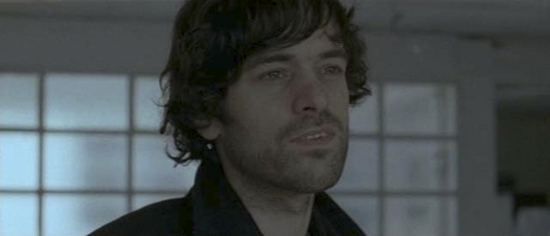
- Romain Duris
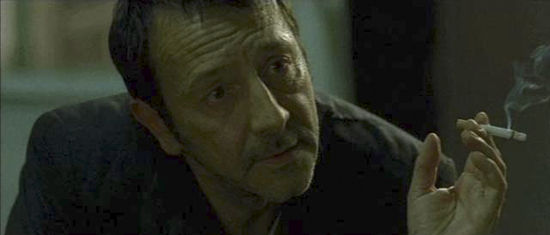
- Jean Hughes Anglade

- Charlotte Gainsbourg
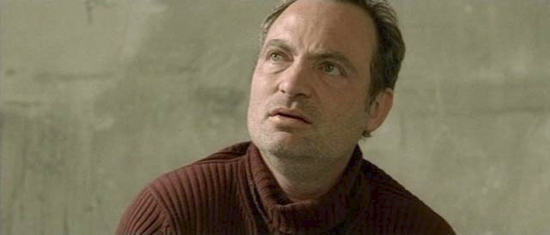
- Gilles Cohen
Watching Patrice at work and having some knowledge of Claire Denis’s films, I had the impression that Patrice applies a three dimensional choreography – « theatrical », whereas Claire seems to be more flat, more two dimensional – « cinematic ».
YC : Claire loves what is beautiful. That is where it all begins. In a scene, she will immediately be on the lookout for what maybe be beautiful in it: it could be the light, an actor’s glance, a prop, a scenery – and that can change the directing completely. That is, a scene written with a character lying in bed… if all of a sudden she sees an actor drinking a cup of coffee at the bar in the morning and she likes this, she will direct the scene from there, not from what was written. That can become disturbing for everyone involved. She looks for what she thinks is the most beautiful, and she will start directing from there. You could actually say that her look is almost one-dimensional: the face in its environment. Patrice, you could say, is a real choreographer: he wants people to talk, to move, he wants incident. But both try to recreate what is natural to them. Certain dialogue rushes really look as if they were documentary! Patrice tries to get everyone to that point. He would like technique to give him the liberty to achieve that. It is not really for that reason that certain set-ups are heavy, but if they are, it will be to achieve that.
You mentioned the rushes: they are known to have become a rather catastrophic problem nowadays – crews watching their work less and less… What was your experience with both projects?
YC : With Claire it’s simple: she does not want to watch the rushes. They make her feel demoralized. So we were in Africa, and Claire did not see the rushes. The producer watched them in Paris and I occasionally watched them on DVD. Furthermore, I had freeze frames the lab sent me on the internet. Claire does not like to look back, she wants to move ahead. Quite the contrary, as a matter of fact, with Patrice – she does not want to start doing things over. With Patrice, things are quite different: he watches all the rushes, entirely, synchronized. From the beep to the very end. He also watches the Mini DV recorded by the video assist , which explains why he wants to do reshoots the day after.
When you say he watched everything, he watched them with you ?
YC : For practical reasons, Patrice watches the synchronized rushes on a DVD at home, on his TV screen. He likes to analyze what has been done. The visual quality of these DVDs is very poor, which is why I watched the rushes twice! Once on a silent Mini DV, which has better quality, and once on a DVD to watch the actors. We also often used these Mini DV for shots that had to be done over or which would have to be added to a sequence: along with our notes they allowed us to verify what we had done lighting wise. I still have not found a proper solution to the problem of rushes. Colour graded rushes are necessary nowadays because that is what the director and editor will be watching for months on end, but also because they are likely to be used for promotion purposes, to be shown to co-producers etc. These colour graded rushes can be deceiving. The graders who do them are rarely the same people who will perform the colour grading of the final film. They work under high pressure, both from the lab and from us. They consequently tend to “flatter” the image and you will not necessarily see that later. Which explains the useless discussions between the director and the colour grader. I remember what Olivier Chiavassa once said at Eclair, when I was assistant to Michel Abramowicz – the rushes were still “one light” at the time. To help the camera operators, Eclair had begun to make colour graded rushes. I remember Olivier furiously saying: «But it’s really stupid what they are doing! They must supply “one light” rushes, because if there are errors, you will not be able to see them. You won’t be able to make an analysis of your rushes, and that is disastrous». With the video rushes, we are having the same problem. But we know that with “one light” video rushes things do not work either. This problem really needs to be solved.
Did the editors leave your image untouched in these two cases? Not even on the AVID ?
YC : Not without notifying me or talking to me about it first. Mostly they wanted to discuss the chronology and I always ask them to do a test at the lab to find out if it works.
Let’s discuss your collaboration with Claire Denis, that was also new for you. You shot in Africa. How did the preparations go ?
YC : White Material is set in a coffee plantation in Africa. Claire scouted locations in various African countries, but we finally decided on Cameroun, a country she knows well and which she likes very much: she lived there as a child with her family and she shot her first film, Chocolat, there. She knows a lot of people there, too. I joined the crew once the location was chosen. The film had to be shot during the harvest season. We went there with all crew leaders and took local technicians along as well. And it went very well. I have made numerous films abroad and I greatly enjoy it. Because when you go abroad, you are forced to abandon our habits, to find your own solutions and manage things yourself. Here, we have a strong tendency to have ourselves assisted for all kinds of things and to reap the benefit ourselves! As far as light was concerned, there were two problems I had to solve down there in Cameroun. The very bright white skies, which produce an extremely soft light, tended to flatten out the image. And the other way around: the zenithal sun from morning to evening never shines on people’s faces. Together with Claire we tried to find a solution, either by re-arranging the working schedule, or by changing the sets, or by choosing a different frame.
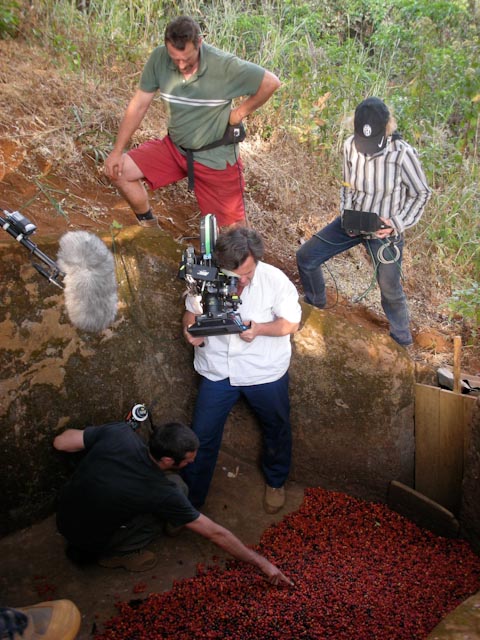
Yves Cape, camera on shoulder. Behind him, leaning over, Maxime Cointe, assistant cameraman, Stéphane Thiry, grip, and Claire Denis during the shoot of White Material
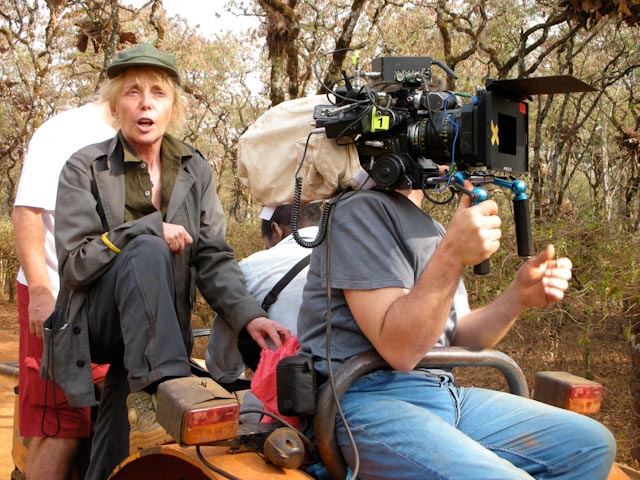
Claire Denis and Yves Cape, Aaton on shoulder during the shoot of White Material
Claire has made several films in Africa, indeed, and worked with black actors as well. Have you watched any of these films together, or new ones ? How did she discover her new DOP – she was, after all, entering undiscovered territory…
YC : She started from scratch, set out on undiscovered territory. She told me things she did not like about the faces of black people. She did not show it, she told me about it. I myself watched several films that had been shot in Africa. Claire did not want that yellowish image you usually get at daytime. She wanted a bright but neutral image, slightly magenta – which embellishes Isabelle Huppert incredibly, by the way: it accentuates her freckled white skin and her red hair. We have made a very bright, sometimes even blinding film in the daytime scenes.
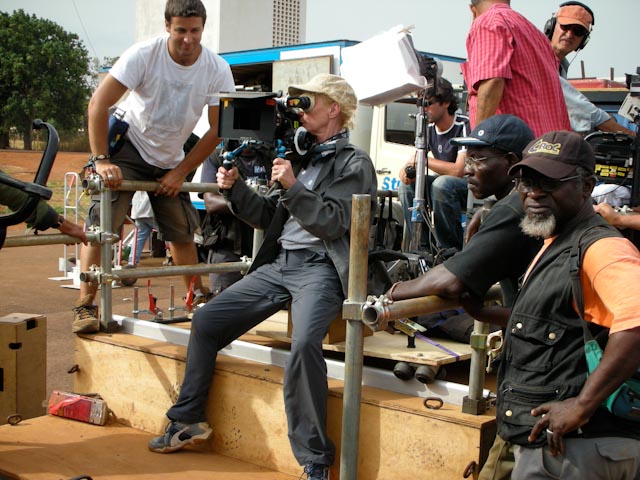
Martin Levent, 2nd assistant cameraman, and Claire Denis, looking into the viewfinder of the Aaton during shoot of White Material
Will Claire’s film be graded photo-chemically ?
YC : Yes, Claire hates the digital. She has graded 35 Rhums digitally and I believe she no longer wants to hear about it. At least not at this moment…
So, what film stock did you choose?
YC : During preparation, we went to Cameroun for ten days to watch the scenery, to meet people, make shots of coffee plantations and try out various types of film stock. Unfortunately, our material was x-rayed and ruined by Air-France! We did manage to save a couple of shots, though, which are now in the film. The 5245 tryouts were magnificent. It has a very neutral but very sharp quality Claire likes very much. The problem was that I could not use the 45 to work with Isabelle Huppert because of her contrast. I would have been obliged to set up lighting equipment that was not at my disposal. So I used the 45 for landscape shots and certain sequences. Most of the film was shot on the 200 and 500 for the night sequences. Both for Claire’s, or for Patrice’s film, I rarely used filters: maybe I’ll do some more diffusing in the future. If you want to be able to shoot in all angles and rapidly, it’s true you need to diffuse the image a bit more. That will be very helpful when the colour grading has to be performed.
Especially considering that nowadays, you can have a complete range of discrete filters at your disposal…
YC : I usually filter a little bit for facial close ups. Claire does not like it. You cannot transform the actor’s face, you must not betray it in a certain sense. It is the same thing during the colouring: if a shot is not beautiful, you must not try to doctor it up during grading. If it is not beautiful, it is not beautiful.
The following photograms are excerpted from the film White Material by Claire Denis, shot by Yves Cape
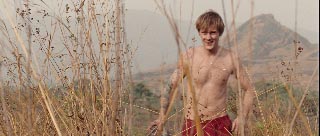
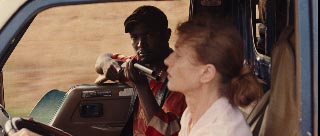
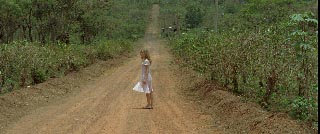
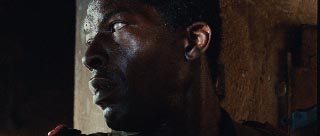
Was this the first time Isabelle Huppert worked with Claire Denis?
YC : They had been wanting to work together for a while. Claire did the writing together with Marie Ndiaye. Marie Ndiaye did some pre-location scouting in Africa with Claire to get the feel and the view of the whites’ coffee plantations. It is a very beautiful script.
Knowing Claire, Isabelle knew that her image would be put at stake…
YC : Something astonishing happened during this film. All our material, except the camera material, which arrived by plane, grip, light, make up, technical equipment, everything that arrived by boat was blocked at the port of Douala for three weeks. As a result the production wanted to postpone the shooting. But because of the importance of the season, Claire did not want that and so, we decided to start shooting anyway. Claire talked things over with Isabelle, and she agreed. We rescheduled the work plan, starting with exterior shots, obviously. We improvised reflectors, using sheets from our hotel rooms fixed on to a wooden frame! And that gave the film real speed. When the material finally arrived, we had not done one single travelling, not used any lighting for the exterior shots, except on a few very rare occasions, and as we were very lightly equipped, we did the night shots very lightly, too. That’s how we worked and things went very well, indeed. Isabelle had soon understood that Claire would not betray her. In the film, there are two or three moments where the light on Isabelle is not really good, and Claire has not been able to cut them, but she has been very careful with them. I admire Isabelle Huppert very much. Claire asked her to do extraordinary things, but Isabelle trusted her fully and was a wonderful help to me, too. She had sensed that I was totally committed to Claire and that I was, therefore, very concerned about her appearance on screen, and that we would do anything to make her look strong and determined, which is what the film is all about.
Did you have flexible working hours?
YC : It is complicated. To have good light in Cameroun, you have to shoot between 8 and 10 a .m. and between 4 and 6 p.m. !
Not having the seen the films, we are naive enough as to ask questions. Maybe, after we’ve seen them, we may come back to your work. Yves Cape, thank you very much.


